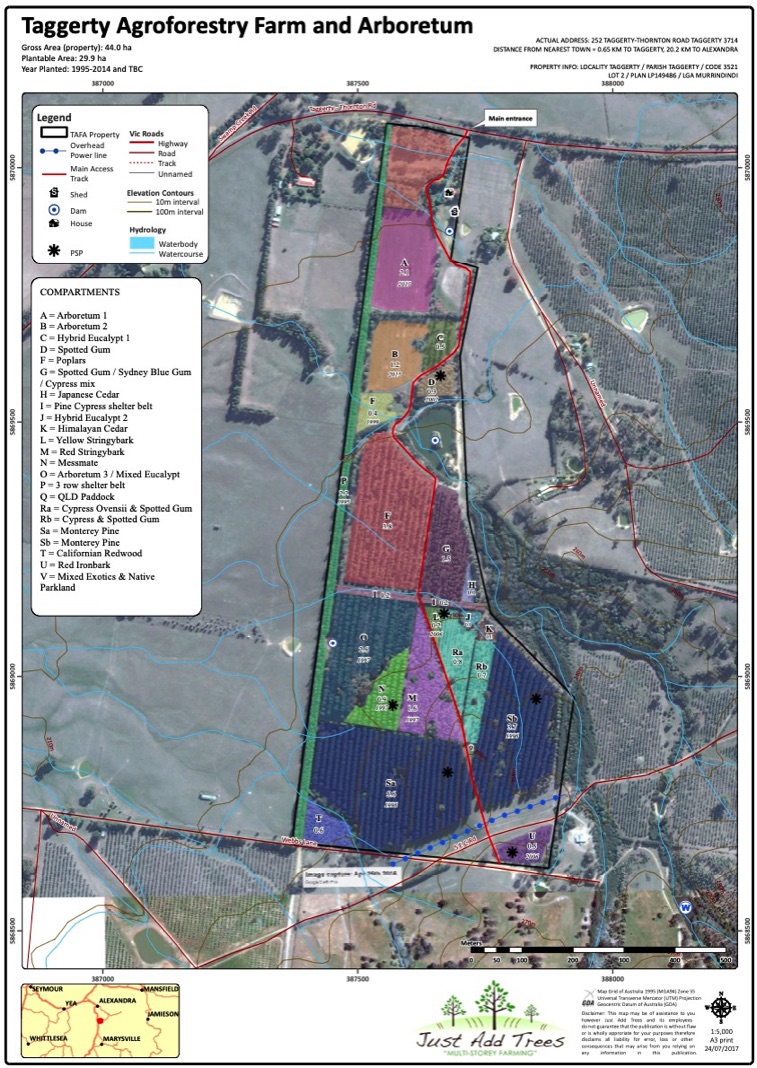Overview of the Taggerty Agroforestry Farm and Arboretum
Taggerty's resident forester and Agroforestry enthusiast, John Woodley, made a major change in direction from Farm Forestry when he declaried his property at Taggerty to be an Arboretum into the future, as well as a functioning Agroforestry Farm.
An Arboretum is "a botanical garden devoted to trees" but Woodley's Arboretum is more than just a collection of trees.
With the help of friends and family, he has established a broad range of trees and shrubs which are unique and very diverse. Apart from the few remnant trees on his 40ha property such as Broadleaf Peppermint, Narrowleaf Peppermint, Red Stringybark, Candlebark, and River Red Gum, the oldest trees that Woodley has planted himself date from 1995, nearly thirty years old.
Consisting of both native and exotic trees and shrubs, the Arboretum, which is also an Agroforestry Farm with a range of layouts for farm trees, provides a constantly changing landscape with the Cathedral Mountain as a spectacular backdrop.
The range of native, deciduous exotics and conifers / evergreen trees is large which means that month by month, throughout the seasons of the year, the colours of the foliage are constantly changing.
Autumn is possibly the most spectacular season of the year with more than 120 species of exotic and native trees and shrubs, having so many different leaf shapes and colours to brighten the onset of cooler weather.

All amenity trees have been pruned to provide a future clear timber resource, if there is a wild weather event that topples the trees.
After 30 years of experimentation, John is the first to admit that there have been some notable mistakes in the Taggerty plantings:
❖ Selecting e-nitens (shining gum) as a timber tree. At first harvest at age 18 (2014) there were many high quality sawlogs. However, the tree is not drought tolerant and, whilst spectacular as a young tree, it does not enjoy waterlogging or clay soil, especially during winter months and is also susceptible to root rot. Nonetheless, timber buyers continue to want the flooring timber that he mills from the Shining Gum trees.
❖ Cupressus Macrocarpa (Monterey Cypress) was selected because of its high value as a timber tree in NZ, where John originally hails from, where Monterey Cypress has four times the retail values of pine. However, it is very susceptible to cypress canker which is a wind-borne fungus which attacks the cambium layer and often results in tree death. Cupressus Lusitanica has proved less susceptible to canker while the NZ-developed cypress clone, the Ovens Cypress, is completely clear of canker and has very good form as a timber tree.
Despite these setbacks, there have also been some notably good decisions in the plantings at Taggerty:
❖ Selecting pine as a basic species for shelterbelts and the plantation.
❖ Selecting Messmate, Red Stringybark, Yellow Stringybark, Spotted Gum, Red Stringybark, Yellow Stringybark, Spotted Gum, Ironbark and various native understorey shrubs for integration with the timber species and shelter belts.
❖ Selecting Redwoods for the plantation area in the far back corner to prevent the back of the property from being neglected. This was done with the expectation that reasonable groundwater would be available for the redwoods, and so far so good.
❖ Himalayan Cedars in the same area are also doing well, but are very susceptible to deer damage when pruned.
❖ Putting native fish species in the dams on the property
❖ Becoming a novice bee keeper. Not plain sailing, and the winter is hard on the bees.
❖ Planting a large variety of exotic and mainly deciduous trees on the property, which unwittingly provided a good basis for an Arboretum.
❖ Meeting people like Rowan Reid, John Coyne and Howard Webster and other clients who have inspired John and encouraged him to continue with what has become his life's work.
In the beginning, John grew trees for expected profit. Now he sees that there is much more to growing trees than money.
This property is a significant part of his life's story and he hopes that it inspires others to paint their own canvas, so to speak, and in so doing, know that they are doing good things for the environment and creating a legacy for future generations.
The Taggerty property is his hobby and his lifestyle which started as a superannuation scheme. It may still fulfil that role in part but the property has evolved into an incredible place to live.
John’s day job has been helping others to establish and manage their trees, which has directly and indirectly helped him to own and maintain this property.
Special points to note:
• Shelter belts combining natives for low shelter, and exotic pines with pruned butts for clear timber.
• Flowering trees that provide an almost year round supply of bee food and food for the Honey Eaters and Eastern Spinebills.
• Beautiful timber for flooring and furniture has been milled from trees planted on this property.
The overall layout of the Taggerty Agroforestry Farm and Arboretum is shown below:

